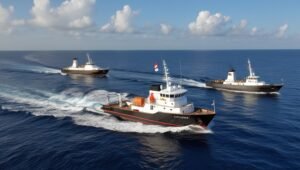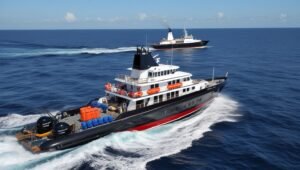
In areas of heavy boat traffic, how can an operator reduce the chance of collisions?
Passing through high-traffic zones is an important responsibility
Driving a boat in high-traffic areas is a complex task that requires vigilance, skill, and strategic decision-making. The stakes are high—one miscalculation could lead to a catastrophic collision. It is therefore important for boaters to adopt a comprehensive approach to minimize the risk of accidents. This article explores effective strategies and best practices that can be used to reduce the likelihood of collisions in heavy boat traffic areas.

Understanding the environment Knowledge is power.
One of the fundamental elements of safe boating in crowded waters is a thorough knowledge of the environment. This includes understanding local waterways, traffic patterns, and potential hazards. Boaters should regularly consult nautical charts and GPS systems to keep abreast of the layout of the area they are navigating.
Nautical Charts These provide detailed information about water depth, the location of submerged objects, and specific traffic lanes. Operators must be proficient in reading these charts to avoid potential hazards.
Local Traffic Patterns Understanding the normal flow of traffic in a particular area can help predict the movement of other vessels. This includes knowing the busiest times of the day and the types of ships that usually come.
Weather Conditions Weather plays an important role in marine safety. Operators must be aware of current and forecast weather conditions to make informed decisions about navigation.
Vigilant observation Eyes and ears on the water
Constant vigilance is essential when working in areas with heavy boat traffic. It is important to keep a sharp eye out for other vessels, obstacles, and changes in water conditions. This can be achieved through a combination of visual observation and technical support.
Visual Scanning Operators must continuously scan the environment using the “10-second rule” – checking all directions every 10 seconds to ensure no hazards are overlooked.
Use of Binoculars In crowded areas, binoculars can help identify distant vessels or objects that may pose a threat.
Radar and AIS Automatic Identification System These technologies provide real-time data on the location and movement of nearby vessels, helping operators maintain a safe distance.
Communication: The key to avoiding misunderstandings
Clear and effective communication is the cornerstone of safe navigation. Miscommunication or the lack of it can easily lead to conflict. Therefore, operators should use all available communication channels to coordinate with other vessels.
Marine VHF Radio This is the primary means of communication between ships. Operators should use the correct channels to communicate their intentions, especially when moving through busy areas.
Acoustic Signals In situations where visibility is poor, acoustic signals may be used to indicate the vessel’s position or intentions. Horn blasts and whistles are standard signals that every operator should be familiar with.
Navigation lights The correct use of navigation lights is very important, especially in low visibility conditions. These lights help other vessels determine your location, direction, and speed, making collisions less likely.
Pace Management Control is very important.
Speed is an important factor in preventing collisions. Operating at a speed that is too fast for the conditions can significantly increase the risk of an accident. Operators must adjust their speed

based on several factors
Traffic Density In heavy traffic areas, slower speeds allow more time to react to unexpected situations.
Visibility Reduced visibility due to fog, rain, or darkness requires a reduction in speed to allow safe navigation.
Proximity to other vessels The closer the vessels are to each other, the lower the speed must be to ensure safe maneuvering.
Regular Training Operators must undergo regular training to stay updated on the latest navigation techniques and safety protocols.
Simulation scenarios Training in a simulated environment can prepare operators for real-world situations, helping them react quickly and appropriately to potential threats.
Experience Experience is the best teacher. Operators who have spent considerable time navigating a variety of conditions are better equipped to handle the challenges of heavy boat traffic.
Emergency Preparedness Being prepared for the unexpected
Despite all precautions, emergencies can still occur. Therefore, operators must be prepared to respond quickly and effectively to any situation.
Emergency Drills Regularly conducting emergency drills ensures that all staff members know their roles and can act quickly in a crisis.
The vessel should have all necessary safety equipment, including life jackets, fire extinguishers, and emergency beacons.
Contingency plans Operators should have contingency plans for various types of emergencies such as collisions or grounding.
The result Safely navigating through heavy traffic
Finally, areas with heavy boat traffic require knowledge, vigilance, communication, and adherence to navigation rules to reduce the likelihood of collisions. By integrating these elements into their daily operations, boaters can safely navigate even the most crowded waters, protecting both their vessel and those around them.

Adherence to Navigation Rules Law of the Water
The International Regulations for the Prevention of Collisions at Sea (COLREGs) set out the rules governing the movement of ships in international waters. Strict adherence to these rules is necessary to maintain order and prevent accidents in high-traffic areas.
It is important to understand which vessel has the right of way under different circumstances. For example, powered ships usually give way to ships.
Overtaking and Crossing When overtaking another vessel, the overtaking vessel should keep out of the way. Likewise, when ships are crossing paths, the vessel on the starboard (right) side has the right of way.
Avoiding Close Quarters Ships should avoid close quarters with other ships whenever possible, as this increases the risk of collision.
Using technology Enhancing situational awareness
Modern technology offers a variety of tools that can enhance a boater’s situational awareness and help avoid collisions. Some of these technologies include
Radar systems These provide real-time data on the position and movement of other ships, even in low visibility conditions.
Automatic Identification System (AIS): AIS provides information on the course, speed, and identity of nearby vessels, enabling operators to make informed decisions about their navigation.
GPS and Chartplotters These systems provide accurate positioning information and help operators stay on course even in difficult conditions.
Training and Experience The Human Factor
While technology and knowledge are critical, operator skill and experience ultimately determine ship safety. Continued training and experience in various navigation scenarios can significantly reduce the likelihood of collisions.
